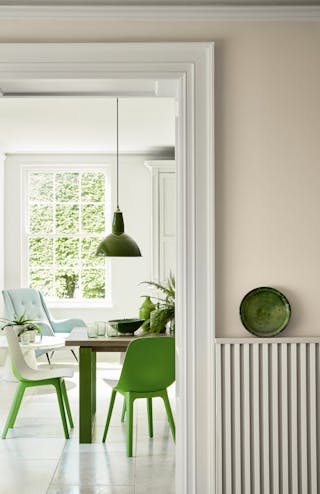Refreshing woodwork within a space is a simple and effective way of updating an existing scheme. Often, baseboards are painted a neutral or white shade out of habit, but their proportion makes them the perfect opportunity to add a little colour.
All-Over: Paint Walls and Baseboards in the Same Tones
Paint walls and baseboards in the same shade for an all-over wrap-around scheme that feels comforting and enveloping. This works particularly well with warm, jewel-tones or muted greens to evoke serenity and the calm of the outdoors.
Coordinated Colours: Select a Deeper Shade for Woodwork
Combine colours from the same Colour Scales families for a harmonious finish. Use a deeper strength of the same pigment on woodwork, alongside a lighter shade on walls for a gentle contrast. For example, use Portland Stone on woodwork with Portland Stone - Light on the walls.
Colour Highlight: Use Bold Tones on Baseboards
If you’re using a wallpaper pattern within a space, consider pulling out a bold shade from within the design to draw all elements of the scheme together. When creating a colour highlight, the paint you use on baseboards and doors depends on the accent colours within your wallpaper. Here, our Bird & Bluebell - Pea Green wallpaper is paired with a strong colour highlight of Puck on the baseboards, and the complementary pink, Blush, on the ceiling.
Colour Block: Use Colour Blocking For A Focal Point
Elongate baseboards by using the same colour on woodwork and the lower half of the wall to create contrast and a focal point in place of architectural features.
Neutral: Opt For Neutral Baseboards
For a timeless finish, use an off-white or clean white to complement your chosen wall colour and enhance baseboard and door frames. If white feels a little bright, consider a neutral like French Grey - Pale or Slaked Lime for a softer contrast.
How to Paint Baseboards: Step by Step
When choosing which paint to use on baseboards, we recommend the following finishes: Intelligent Satin, Intelligent Eggshell or Intelligent Gloss.
For baseboards, trims, interior doors, panelling, and architectural features such as chair rails and picture rails, we would recommend following the below steps when beginning a project.
Woodwork tends to attract more dirt than walls so ensure you clean the surface before painting. Use a small amount of detergent wet ‘n’ dry abrasive paper to clean and sand the surface at the same time.
- Protect the floor with newspaper or cardboard, using masking tape to secure it at the edges. Whether you’re painting baseboards with carpet or hard floors alongside, a secure protective layer is vital.
- Ensure any old flaking paint is entirely removed and fill any surface abrasions and sand them to a smooth finish. The paint will provide a beautiful finish but it isn’t capable of concealing cracks and holes.
- Previously painted woodwork in good condition should be sanded back to provide a key, this is particularly important for glossy finishes. If the surface is consistent, no other undercoats should be required. Otherwise apply one coat of Little Greene Intelligent ASP (All Surface Primer).
- Use a small brush to apply paint at the extremities of the surface and into any intricate mouldings. Take care not to let the paint pool in crevices where it will slowly sag or drip while it dries.
- Larger areas are efficiently covered with the use of a small foam roller or bigger brush, depending on scale. A popular way of painting woodwork is to use a roller to efficiently apply the paint, and a brush to ‘lay-off’ the surface while the paint is still wet. This avoids the orange-peel effect associated with overly-hasty paint application, or too long a nap (of the roller!).
Explore our wood paint finishes in more detail before choosing the best paint for your project.
















